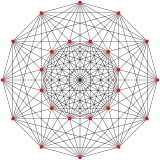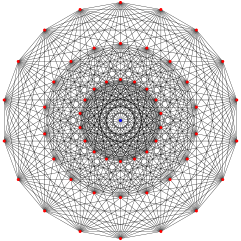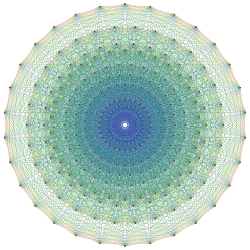5 21 honeycomb
In geometry, the 521 honeycomb is a uniform tessellation of 8-dimensional Euclidean space. The symbol 521 is from Coxeter, named for the length of the 3 branches of its Coxeter-Dynkin diagram.[1]
| 521 honeycomb | |
|---|---|
| Type | Uniform honeycomb |
| Family | k21 polytope |
| Schläfli symbol | {3,3,3,3,3,32,1} |
| Coxeter symbol | 521 |
| Coxeter-Dynkin diagram | |
| 8-faces | 511 {37} |
| 7-faces | {36} |
| 6-faces | {35} |
| 5-faces | {34} |
| 4-faces | {33} |
| Cells | {32} |
| Faces | {3} |
| Cell figure | 121 |
| Face figure | 221 |
| Edge figure | 321 |
| Vertex figure | 421 |
| Symmetry group | , [35,2,1] |
This honeycomb was first studied by Gosset who called it a 9-ic semi-regular figure[2] (Gosset regarded honeycombs in n dimensions as degenerate n+1 polytopes).
Each vertex of the 521 honeycomb is surrounded by 2160 8-orthoplexes and 17280 8-simplices.
The vertex figure of Gosset's honeycomb is the semiregular 421 polytope. It is the final figure in the k21 family.
This honeycomb is highly regular in the sense that its symmetry group (the affine Weyl group) acts transitively on the k-faces for k ≤ 6. All of the k-faces for k ≤ 7 are simplices.
Construction
It is created by a Wythoff construction upon a set of 9 hyperplane mirrors in 8-dimensional space.
The facet information can be extracted from its Coxeter-Dynkin diagram.
Removing the node on the end of the 2-length branch leaves the 8-orthoplex, 611.
Removing the node on the end of the 1-length branch leaves the 8-simplex.
The vertex figure is determined by removing the ringed node and ringing the neighboring node. This makes the 421 polytope.
The edge figure is determined from the vertex figure by removing the ringed node and ringing the neighboring node. This makes the 321 polytope.
The face figure is determined from the edge figure by removing the ringed node and ringing the neighboring node. This makes the 221 polytope.
The cell figure is determined from the face figure by removing the ringed node and ringing the neighboring node. This makes the 121 polytope.
Kissing number
Each vertex of this tessellation is the center of a 7-sphere in the densest known packing in 8 dimensions; its kissing number is 240, represented by the vertices of its vertex figure 421.
E8 lattice
contains as a subgroup of index 5760.[3] Both and can be seen as affine extensions of from different nodes: ![]()
contains as a subgroup of index 270.[4] Both and can be seen as affine extensions of from different nodes: ![]()
The vertex arrangement of 521 is called the E8 lattice.[5]
The E8 lattice can also be constructed as a union of the vertices of two 8-demicube honeycombs (called a D82 or D8+ lattice), as well as the union of the vertices of three 8-simplex honeycombs (called an A83 lattice):[6]




































































Regular complex honeycomb
Using a complex number coordinate system, it can also be constructed as a regular complex polytope, given the symbol 3{3}3{3}3{3}3{3}3, and Coxeter diagram ![]()
![]()
![]()
![]()
![]()
![]()
![]()
![]()
![]()
Related polytopes and honeycombs
The 521 is seventh in a dimensional series of semiregular polytopes, identified in 1900 by Thorold Gosset. Each member of the sequence has the previous member as its vertex figure. All facets of these polytopes are regular polytopes, namely simplexes and orthoplexes.
| k21 figures in n dimensional | |||||||||||
|---|---|---|---|---|---|---|---|---|---|---|---|
| Space | Finite | Euclidean | Hyperbolic | ||||||||
| En | 3 | 4 | 5 | 6 | 7 | 8 | 9 | 10 | |||
| Coxeter group |
E3=A2A1 | E4=A4 | E5=D5 | E6 | E7 | E8 | E9 = = E8+ | E10 = = E8++ | |||
| Coxeter diagram |
|||||||||||
| Symmetry | [3−1,2,1] | [30,2,1] | [31,2,1] | [32,2,1] | [33,2,1] | [34,2,1] | [35,2,1] | [36,2,1] | |||
| Order | 12 | 120 | 1,920 | 51,840 | 2,903,040 | 696,729,600 | ∞ | ||||
| Graph |  |
 |
 |
 |
 |
 |
- | - | |||
| Name | −121 | 021 | 121 | 221 | 321 | 421 | 521 | 621 | |||
See also
Notes
- Coxeter, 1973, Chapter 5: The Kaleidoscope
- Gosset, Thorold (1900). "On the regular and semi-regular figures in space of n dimensions". Messenger of Mathematics. 29: 43–48.
- N.W. Johnson: Geometries and Transformations, (2018) 12.5: Euclidean Coxeter groups, p.294
- Johnson (2011) p.177
- http://www.math.rwth-aachen.de/~Gabriele.Nebe/LATTICES/E8.html
- Kaleidoscopes: Selected Writings of H. S. M. Coxeter, Paper 18, "Extreme forms" (1950)
- Coxeter Regular Convex Polytopes, 12.5 The Witting polytope
References
- Coxeter The Beauty of Geometry: Twelve Essays, Dover Publications, 1999, ISBN 978-0-486-40919-1 (Chapter 3: Wythoff's Construction for Uniform Polytopes)
- Coxeter, H. S. M. (1973). Regular Polytopes ((3rd ed.) ed.). New York: Dover Publications. ISBN 0-486-61480-8.
- Kaleidoscopes: Selected Writings of H.S.M. Coxeter, edited by F. Arthur Sherk, Peter McMullen, Anthony C. Thompson, Asia Ivic Weiss, Wiley-Interscience Publication, 1995, ISBN 978-0-471-01003-6
- (Paper 24) H.S.M. Coxeter, Regular and Semi-Regular Polytopes III, [Math. Zeit. 200 (1988) 3-45]
- N.W. Johnson: Geometries and Transformations, (2015)
Fundamental convex regular and uniform honeycombs in dimensions 2-9 | ||||||
|---|---|---|---|---|---|---|
| Space | Family | / / | ||||
| E2 | Uniform tiling | {3[3]} | δ3 | hδ3 | qδ3 | Hexagonal |
| E3 | Uniform convex honeycomb | {3[4]} | δ4 | hδ4 | qδ4 | |
| E4 | Uniform 4-honeycomb | {3[5]} | δ5 | hδ5 | qδ5 | 24-cell honeycomb |
| E5 | Uniform 5-honeycomb | {3[6]} | δ6 | hδ6 | qδ6 | |
| E6 | Uniform 6-honeycomb | {3[7]} | δ7 | hδ7 | qδ7 | 222 |
| E7 | Uniform 7-honeycomb | {3[8]} | δ8 | hδ8 | qδ8 | 133 • 331 |
| E8 | Uniform 8-honeycomb | {3[9]} | δ9 | hδ9 | qδ9 | 152 • 251 • 521 |
| E9 | Uniform 9-honeycomb | {3[10]} | δ10 | hδ10 | qδ10 | |
| En-1 | Uniform (n-1)-honeycomb | {3[n]} | δn | hδn | qδn | 1k2 • 2k1 • k21 |